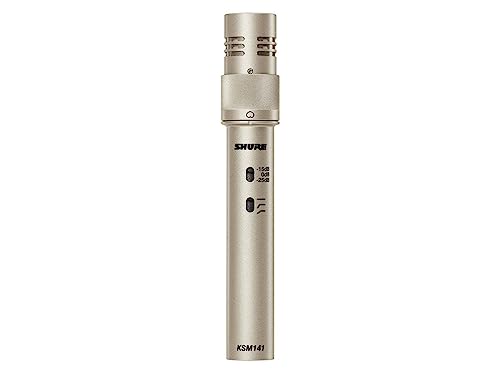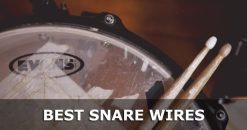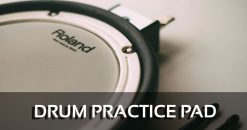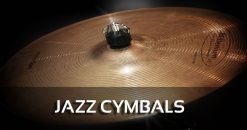
If you’re determined to mic your drums for a stage performance or a recording, you can’t really settle for just any microphone. You really do need to make sure you get the best overhead drum mics. Anything that’s of less quality will simply result in a disaster.
For experts and studio professionals, the gold standard of what makes for the best is the classic Neumann SKM 184. If you can afford that or you’re setting up your own recording studio, then that’s what you need to get for your drums. It’s undoubtedly excellent, but it’s the kind of excellence that comes with a high price.
Since not all of us can afford such an industry standard, we’ve compiled a list of still terrific alternatives that come with similar performance but with a more palatable price tag.
Contents
Top 5 Overhead Drum Mics: Comparison Chart
Name of Mic | Type | Size | Weight | View On Amazon |
|---|---|---|---|---|
Cardioid | 16 x 5 x 12 inches | 5.6 ounces | ||
Cardioid | 11 x 3.2 x 4.8 inches | 1.5 pounds | ||
Cardioid | 16 x 5 x 12 inches | 5.3 pounds | ||
Dual pattern: cardioid or omnidirectional | 5.8 x 0.8 x 0.8 inches | 5.4 ounces | ||
Super-cardioid | 5.3 x 2.6 x 13.8 inches | 2.05 pounds |
Best Picks of Overhead Drum Mics
#1: Rode M5 Compact 1/2″ Condenser Microphone
- Matched of pair small-diaphragm cardioid condenser microphones
- 1/2-inch gold-sputtered capsules
- Carefully selected pair with no more than 1dB sensitivity variation
- Very low noise and full frequency response
- Includes microphone clips and windshields
- 10-year warranty
Last update on 2025-11-12 / Affiliate links / Images from Amazon Product Advertising API
This is sold as a matched pair, so that you can have and record your sound in true stereo. The mics have been carefully selected so that they won’t differ more than 1dB in sensitivity. It’s an Aussie brand with a small diaphragm, and it’s versatile enough for drums and violins.
As this is a cardioid mic, it can offer low noise sound. Yet it also offers a full frequency response, so it can capture the deep thrum of the bass as well as the sharp sound of the cymbals. You can even use this to mike the audience.
It’s very compact for portability, and it comes with a special ceramic coating to give its sleek matte finish. It also comes with its own RM5 stand mounts along with WS5 windshields.
It will give you the high quality sound you want, whether you’re performing for an audience or in a recording studio. It’s quite durable too.
- It’s small enough to bring along easily to your gigs.
- It’s great for multiple functions, from drums to stringed instruments to the audience.
- You get very low noise.
- It has a full frequency response.
- It’s quite durable.
#2: Samson C02 Pencil Condenser Microphones
- Small-Diaphragm Pencil Condenser Microphones
- Stereo Pair (Matched within ±0.5dB Sensitivity of Each Other)
- Cardioid Pickup Pattern
- Up to 134dB SPL, Gold-Plated XLR Connectors
- Protective Carry Case, 2 Shock-Mounted Mic Clips, & 2 Windscreens Included
- Samson Audio (Author)
- English (Publication Language)
Last update on 2025-11-12 / Affiliate links / Images from Amazon Product Advertising API
This is also sold as a stereo pair with a cardioid polar pattern. The polar pattern ensures that it will only capture the sound that comes from a very narrow area in front of it. This means you don’t capture ambient room noise or the music produced by other instruments on stage or in the room. You also don’t have to deal with monitors that can cause mic feedback.
Its frequency response is also extremely wide, which works well for your drums. In fact, it’s wide enough to accommodate other instruments, including acoustic guitars, flutes, and trumpets. You can use this for vocals too. The small diaphragm allows you to capture the high notes with no trouble. It’s great for cymbals along with violins.
This is set up with portability in mind. Aside from its compact size and low weight, it also comes with a handy carrying case. This even comes with a set of shock-mounted mic clips so setting up the mics isn’t a problem.
The real surprise here is that its quality is quite impressive, yet the price is shockingly low. It seems too good to be true. But with this you really do get a lot of value for your money.
- It’s inexpensive.
- It’s easy enough to bring along on the road.
- The clarity is terrific, with clean sounds with no noise. It can capture both high and bass tones.
- It sells as a pair for stereo clarity.
- It can be used for many different types of instruments, including voices. You can also use this as your video mic.
#3: Rode NT1-A-MP Stereo Matched Pair
- Large 1” capsule with gold plated diaphragm. Maximum SPL is 137 dBSPL
- Cardioid polar pattern; True condenser (externally biased)
- Ultra low noise, self noise of only 5dB (A)
- Includes one microphone that can be used as a stereo matched pair
- Nickel-plated body
- Unrivaled low distortion
- Ultra-low self noise (5
Last update on 2025-11-12 / Affiliate links / Images from Amazon Product Advertising API
Here’s another pair of mics, which should tell you right now that a single mic doesn’t work as well if you’re setting up mics for your drums. It’s a bit on the pricey side, but then that’s justified by its high quality and excellent features.
First of all, this features a large gold-plated diaphragm. It offers outstanding clarity, with a super bass response to go along with its ability to capture the sharpness of your cymbals. With its wide dynamic range, it’s not limited to just your drums. You can use this to mic your other instruments. In fact, many also use this as a vocal microphone.
It’s not just versatile, but it’s also capable of accurate recordings. It features extremely low distortion so you record what the music actually sounds like.
Another special characteristic of the Rode NT1-A is that it has a very low self-noise level. It’s actually one of the quietest microphones in the whole world. Its cardioid polar pattern really concentrates on the sounds coming right in front of it. It doesn’t pick up ambient noise, nor does it capture the sounds made by other instruments on stage.
It’s also not all that heavy and large, so it’s portable as well. It’s quite tough too, as the mic bod has nickel plating.
- It’s very durable.
- Its large diaphragm offers an extremely wide dynamic range.
- You can use this for various types of instruments, or for vocals.
- You don’t get too much ambient noise.
- It’s also portable.
#4: Shure KSM141/SL Dual-Pattern
- Cardioid or omnidirectional polar pattern, ultra-thin diaphragm, transformer less Preamplifier circuitry
- Switchable pad (25dB, 15dB) for very high input SPL sources
- Three-position switchable low-frequency filter minimizes background noise and proximity effect
- Subsonic filter eliminates low frequency rumble (less than 17 Hz) caused by mechanical vibration
Last update on 2025-11-12 / Affiliate links / Images from Amazon Product Advertising API
This can be sold individually, though as a pair you can get a discount. This is also quite expensive, but then it offers features you don’t get from other mics.
First of all, this comes with a dual polar pattern. You can use it as a cardioid mic so you only capture the sound made by what’s right in front of it. Or you can use it as an omnidirectional mic so you can capture all the sounds coming from all directions.
This also uses a small diaphragm, so that it can capture sharp sounds very faithfully. Its transformer-less preamplifier also helps ensure that you don’t suffer from any sort of distortion at all. It also comes with a subsonic filter that greatly reduces the low frequency rumble you can get from any mechanical vibration.
With this, you have a switchable pad so you can handle extremely high sound pressure levels. The switchable low-frequency filter can also help minimize the background noise
All these features allow you to use these mics for an extremely wide range of instruments, including acoustic instruments, winds, low frequency instruments like basses, and coral ensembles.
- It can be used for many different types of instruments, or even for the whole orchestra.
- It minimizes distortion.
- You reduce the background noise.
- It can handle high SPLs.
- It offers a flat response with a warm sound.
#5: Sennheiser MD 441-U
- Accurate and versatile dynamic microphone with integral pop filter, perfect for vocals and virutally every instrument
- Precise and distortion-free reproduction even at the highest sound pressure levels
- Spring capsule mounting provides low sensitivity to handling noise
- Five-position low frequency contour switch and two-position high frequency switch
- Hum compensating coil
Last update on 2025-11-12 / Affiliate links / Images from Amazon Product Advertising API
Now unlike the others, this isn’t a condenser mic but a dynamic one. That means it’s tough and won’t warp easily. But it also offers the accuracy and dynamic range you’d expect from a condenser mic.
Part of its excellence is due to its super-cardioid polar pattern. This means that it only picks up the sound from a much narrow range in front of it.
It also has multiple settings so that you can set it up to best suit your sound environment. It has a 5-position low frequency contour switch, along with a 2-position high frequency switch.
It also minimizes noise extremely well. It comes with a damped internal shock suspension along with a hum bucking coil.
- The signal to noise ratio is startling, with extreme clarity and low noise.
- It doesn’t pick up the other sounds outside its narrow source range. It really does isolate the sounds from right in front of it.
- It works very well with drums, with a nice full tone.
- It also works with many other types of instruments including vocals.
- This will last for a very long time.
Why Do You Need Overhead Drum Mics?
The mics have to be overhead for the simple reason that there’s no other place for them. You can’t have them right beside you, since they’d just be in the way.
There are 2 basic reasons why you would need a set of overhead mics. The first reason is for recording your beats. You can then use it to mix with other instruments or edit the beat with your music editing software.
The other main reason for mics is to project the sound over a larger area. Sure, drums are actually loud instruments. But for stadiums, mics are certainly going to be necessary so that everyone can hear them.
How to Choose Overhead Drum Mics
Choosing the best drum mics won’t be easy, so you may as well trust the experts in the music industry. Virtually all of them recommend that you get a condenser microphone, which is different from dynamic and ribbon microphones.
Dynamic microphones are very tough, and you can have them close to your drums and these mics won’t warp. But the main problem with them is that they’re not all that sensitive, so they don’t offer you as much detail in the sound you create.
On the other hand, ribbon mics are certainly sensitive—and perhaps overly so for drums. With sharp sounds and high dynamics, they can warp quite easily.
Now you can have the best of both worlds when you get a condenser mic. These mics can be as durable as dynamic mics, and also offer as much detail as a sensitive ribbon mic.
Before you make your choice, you need to read plenty of overhead drum mics reviews so that you can find out for yourself what kind of performance you can really expect. Some can be the best drum mics for live sound which works for your gigs, while others can be better for recording sessions in a studio, or even in your home.
You may also want to decide whether you want the best mic for toms live, or if you want to highlight your cymbals. That means picking the mic with the right size of diaphragm. The larger diaphragm will be more sensitive and have a deeper frequency response, while a smaller diaphragm can be best if you want to pay more attention to your cymbals.
Things to Consider before Buying Overhead Drum Mics
When you read advertisements and reviews on overhead drum mics, you should check closely for the following factors:
- Is it a condenser mic? Condenser mics are generally regarded as best suited for drums.
- What’s the polar pattern? The polar pattern decides how sensitive the mic is relative to the direction from which the sound is coming from. So an omnidirectional mic is equally sensitive to sound from all directions. A cardioid polar pattern is much better for drums, as it is extremely sensitive at the front. It doesn’t respond to ambient sound and it’s more resistant to feedback.
- How much does it cost? Professional studio equipment can run up to $1,500 or more, but not all of us can afford that. However, some can cost less than $100.
- What’s the sound quality really like? Here’s how helpful the customer reviews can be.
- How durable is it?
- Can it work for other types of musical instrument? It would be nice if you don’t have to buy different mics for different instruments.
Final Verdict
Get the Sennheiser. This is another great example of German engineering, and the Sennheiser MD 441-U won’t let you down. It’s used by professionals all over the world, and you get your money’s worth and more. It can be used for multiple applications and instruments, it faithfully captures only what you want, and it reduces noise admirably. It may be a bit expensive, but with proper care it will last you for a lifetime. Among the best overhead drum mics, this is the industry standard you can get without breaking the bank.













